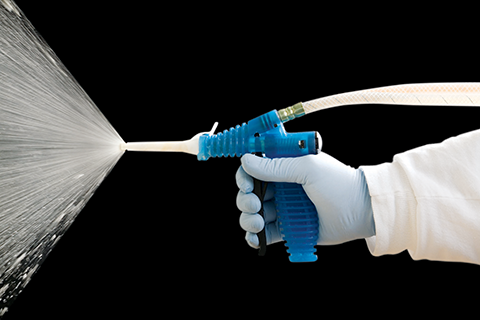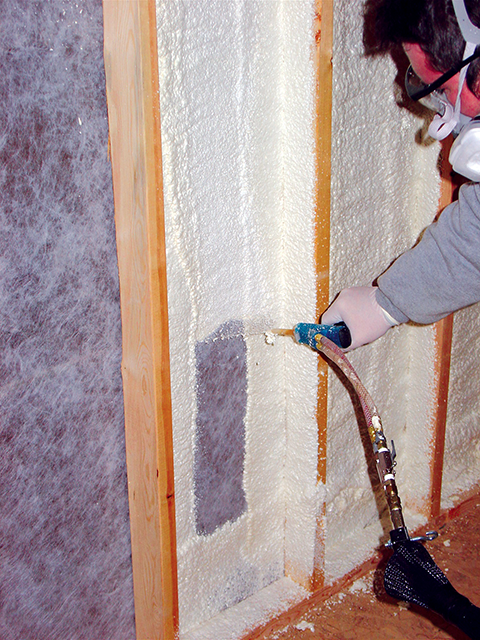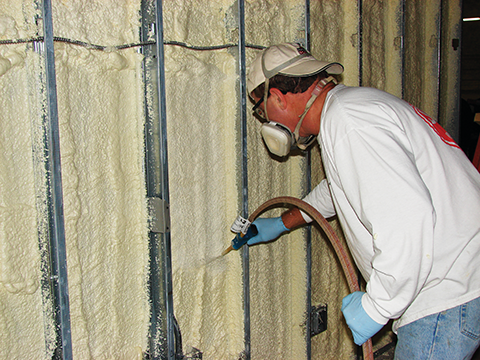Sound-deadening with Sprayfoam: Adding unexpected value with SPF
by Katie Daniel | June 4, 2015 9:29 am
 [1]
[1]by Kristen Lewis
Insulating walls with low-pressure sprayed polyurethane foam (SPF) is a common practice among builders and architects for various reasons—such as increased energy efficiency, structural support, and overall comfort. One of the ways SPF can increase the comfort of a structure is through the material’s sound-deadening properties, which contractors can employ to bring additional value to a project.
Sound-deadening sprayed polyurethane foam in a building can serve several purposes, from mitigating outside noise to enhancing a quiet office space. Multimedia environments, or any specialty rooms where excessive noise can become an issue, can also benefit from SPF as a cost-effective sound-reduction measure.
Traditional sound barrier technology often used within structures—such as vinyl sound barriers and fiberglass products—can be cost-prohibitive for builders or property owners looking to save money or to spend it elsewhere—a ‘nice-to-have,’ though not a ‘necessary’ feature. When builders and architects take advantage of sprayed polyurethane foam insulation for other uses, its sound-deadening effects can come as a bonus, saving time and money in the construction process while increasing the structure’s comfort.
Application of SPF for sound deadening
Several manufacturers offer sprayed polyurethane foam specifically with this acoustic quality in mind. Open-cell sprayed-foam formulations—which are lower density and often less expensive per board foot than closed-cell counterparts—are well-suited to sound-deadening, with high expansion properties to quickly and simply fill voids.
Sprayed polyurethane foam as a sound-deadening measure works for essentially the same reason the material works for mitigating airflow: sound is airborne. By filling wall voids, the foam curbs resonance, keeping the sound from leaving or entering the desired room or space. Sprayed foam can also reduce sounds generated inside wall spaces, caused by flushing toilets, clanging pipes, and other miscellaneous utilities.
Applying sprayed polyurethane foam as a sound barrier, however, differs slightly from applying the product strictly as an insulation material. When used strictly as insulation, effective spots to insulate for thermal efficiency include rim joists, attics, and crawl spaces, as well as the traditional wall application. Sound-barrier spray-foam products should be applied to interior walls throughout areas that typically produce excess noise as noted by the property owner—these can often be interior walls rather than exterior assemblies. Working in conjunction with the building occupant to identify the specific areas where noise control is important to them is a critical part of the process to ensure the best result.
 [2]
[2]No matter the application, all regular safety precautions must be adhered to when applying sprayed foam. The U.S. Environmental Protection Agency (EPA) outlines several key steps for safe polyurethane foam use. These precautions include:
- review the product label for recommended work practices and precautions;
- read through the ventilation guidelines for the product; and
- prevent eye, skin, and inhalation exposures with the appropriate safety gear (e.g. goggles and respirators); and
- exercise caution when determining safe re-occupancy after the polyurethane foam has been applied. EPA recommends allowing the foam to completely cure before re-entry by unprotected persons.
Re-occupation of a space is also contingent on cure times. Additionally, ensuring installers have allowed for the proper cure time length ensures the foam has set properly, and will perform its intended function well into the future.
 [3]
[3]Sound-deadening ratings
Design teams should be armed with the knowledge of which sprayed polyurethane foams are best for various applications. Two ratings ought to be considered by building professionals when considering SPF for sound insulation: sound transmission class (STC) and noise reduction coefficient (NRC).
STC ratings indicate how well a wall assembly blocks airborne sound. Throughout the United States, this is one of the most common evaluations of how well ceilings, floors, doors, exterior, and interior walls block airborne sound. STC ratings reflect decibel reduction among these barriers. Deploying a SPF sound-barrier can help interior residential walls maintain an STC rating of 35 at 76.2-mm (3-in.) thickness, at which loud speech is rendered unintelligible; comparatively, a wall without comparable insulation is typically rated at 25, through which normal speech can be easily understood under average conditions.
NRC ratings are a single-number index for rating how absorptive of sound a material is, in which ‘0’ indicates a material perfectly reflective of sound, and ‘1’ indicates a material is perfectly absorptive of sound. At 76.2-mm thickness, sprayed polyurethane foam insulation can help achieve an NRC rating of .70.
Sound deadening for added value
It is important to note while SPF makes for a useful multipurpose solution with its sound-deadening properties, it is not the only available method for sound-deadening measures. More comprehensive sound-deadening results can be had from dedicated products.
The value of sprayed polyurethane foam as an acoustic measure is it is another addition to an already robust range of benefits the material can bring to any application. It can also be useful for irregularly shaped areas, and is easily workable around obstructions that may exist within wall cavities through its precise dispensation method. Sprayed polyurethane foam helps create an air barrier that blocks air movement throughout building cavities, preventing air leakage that can account for 25 to 40 percent of heating and cooling costs for buildings, according to the U.S. Department of Energy (DOE).
Additionally, by seamlessly filling wall voids, sprayed polyurethane foam can help prevent moisture carried through the air from accumulating within these spaces, which would otherwise have the potential to lead to mold and mildew buildup inside wall cavities. Sprayed polyurethane foam fills cracks and crevices where this could become problematic, and additionally seals passageways where moisture could infiltrate.
Traditional insulation materials and sound-deadening materials are often more cumbersome to work with and can require additional construction if applying within an existing structure. These materials often do not provide as many benefits by themselves, making SPF a cost-effective, multi-purpose choice.
 [4]
[4]Specifying the appropriate SPF
Low-density, open-cell foams typically allow for the appropriate amount of absorption to strike the proper balance between the sound deadening and insulation needs in commercial applications. By filling both of these needs, potential savings can be had on additional air-sealing materials required to meet some local and state building energy code requirements. In addition to the noise control benefit, open-cell SPF can help to dramatically reduce air leakage, and lowering heating and cooling costs.
To bolster the environmental and energy-saving benefits of a sprayed polyurethane foam installation, specifying a product with enhanced environmental properties can be valuable. Since contractors are spraying within office spaces and residences, a product emitting low volatile organic compounds (VOCs) makes for an appropriate choice. There are several certifications project teams can look for when specifying a product with low VOCs, one of the most common being GreenGuard.
GreenGuard-certified products meet world-renowned, comprehensive standards for low emissions of VOCs, helping to maintain healthier indoor environments. This can be an important consideration when choosing sprayed polyurethane foam, for both designers and building owners.
It is also important to consider using products that do not have stipulations on being left exposed, as it creates worry with the building owner/occupants. Further, it is likely such materials may not meet building codes in the future, given the way environmental considerations are becoming increasingly more prominent in building codes.
Conclusion
As is always the case when working with a specialized building material, it is important for builders and architects to contract with trained and qualified sprayfoam installers—keeping an eye out for contractors who are certified through the Spray Polyurethane Foam Alliance’s (SPFA’s) Professional Certification Program is a good place to start. Programs like this one help ensure the contracted professional is trained in the proper methods for SPF installation, and can make a reliable recommendation about the appropriate product for a given job.
It is also critical to keep in mind the need for coordination with mechanical and electrical trades to ensure all applicable systems have been installed (and tested) within walls to receive SPF because they will not be accessible later. This is something the onsite contractor and architect should be working toward in the installation plan.
Kristen Lewis is the national sales manager at Fomo Products. She has been with the company for more than 15 years and has served in multiple roles. As an accredited Building Performance Institute (BPI) Certified Building Analyst, Lewis focuses on finding solutions to building performance and weatherization challenges. She can be contacted at klewis@fomo.com[5].
- [Image]: http://www.constructionspecifier.com/wp-content/uploads/2015/06/dreamstime_l_18543982.png
- [Image]: http://www.constructionspecifier.com/wp-content/uploads/2015/06/spf_FanNozzleSpray.png
- [Image]: http://www.constructionspecifier.com/wp-content/uploads/2015/06/spf_Application-image2.png
- [Image]: http://www.constructionspecifier.com/wp-content/uploads/2015/06/spf_DSC00475.png
- klewis@fomo.com: mailto:klewis@fomo.com
Source URL: https://www.constructionspecifier.com/sound-deadening-with-sprayfoam-adding-unexpected-value-with-spf/